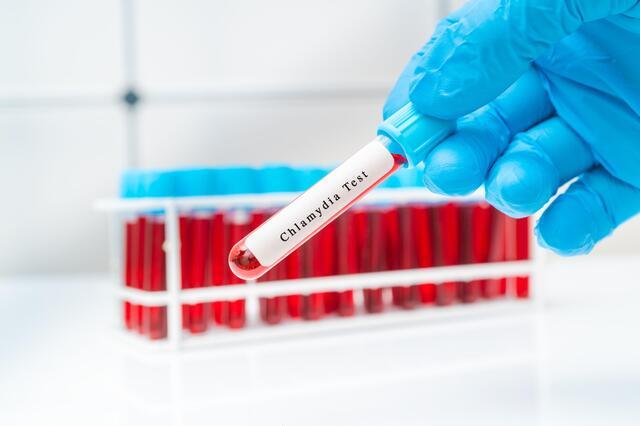“Abstinence-only education – the best STD (Sexually Transmitted Disease) and pregnancy delivery system that politicians have ever devised.”
Rachel Maddow
Chlamydia is a sexually transmitted bacterial infection and affects both men and women.
It does not usually produce symptoms, but it can cause fertility problems. Fortunately, there are effective treatments to combat it.
Causes
Chlamydia is an infection caused by the bacterium Chlamydia trachomatis.
Chlamydia infection can affect several organs, including the penis, vagina, cervix, urethra, anus, eye, and throat. It can cause serious and sometimes permanent damage to the reproductive system.
How is chlamydia spread?
Through unprotected oral, anal or vaginal sex or through genital contact.
Because chlamydia infection usually has no symptoms, a person can be infected and spread it to a sexual partner without knowing it.
It is not possible to transmit chlamydia through:
- Contact with the toilet seat.
- Share a sauna.
- The use of a swimming pool.
- Touching a surface that a person with chlamydia has touched.
- Being near an infected person.
- Coughing or sneezing.
- Sharing an office or home with an infected partner.
A mother infected with chlamydia can pass it to her baby during childbirth. Sometimes the infection causes complications in the baby, such as eye infections or pneumonia.
Women who have been diagnosed with chlamydia during pregnancy should be tested 3 to 4 weeks after treatment to make sure the infection has not returned.


Prevention
Ways to prevent chlamydia or reduce the risk of infection include:
- Use condoms consistently and correctly.
- Limit the number of sexual partners.
- Maintain a sexual relationship in which both partners are monogamous.
- Periodic screening tests.
- Avoid sexual intercourse until treatment is complete.
Symptoms
In most cases, chlamydia is asymptomatic. According to some research, only about 10 percent of men and 5 to 30 percent of women experience symptoms.
It is also unclear how long it takes for symptoms to appear, but it may be several weeks.
In women, symptoms of chlamydia may include discharge from the cervix, easy bleeding, and frequent or painful urination.
If chlamydia spreads to the uterus and fallopian tubes, it can lead to pelvic inflammatory disease (PID). PID can also be asymptomatic and affect fertility.
In men, symptoms may include pain and tenderness and swelling in the testicles or urethra, the tube that carries urine.
Both men and women can develop symptoms in the rectum and anus. The virus can infect these areas during anal sex or by spreading from the reproductive organs. These symptoms include rectal pain and rectal discharge or bleeding.
Contact with infected secretions can also cause chlamydial conjunctivitis.
Lab tests have found chlamydia in the throat of people who have had oral sex with someone who has the infection. However, this usually does not cause symptoms.


Diagnosis
To diagnose chlamydia, the health care provider will perform an exam to look for physical symptoms such as discharge.
He or she will also take a urine sample or a swab of the penis, cervix, urethra, throat, or rectum.
Chlamydia screening
Because chlamydia infection usually has no symptoms, health authorities often recommend screening for some people, such as:
- Sexually active women under the age of 25.
- Pregnant women under 25 or older women if they are at high risk.
- Hombres que pertenezcan a un grupo de alto riesgo.
- Men who have sex with men annually, and every 3-6 months if at high risk.
- Sexually active people with HIV, at least once a year.
How is chlamydia screening performed?
You can test for chlamydia at home or in a lab, using a urine sample or a swab.
Women can swab the sample, place it in a container, and send it to the lab. Men usually use a urine test.
In any case, the doctor will advise on the best option, and may also recommend rectal or throat tests, especially for people with HIV.
These home screening tests can be a little tricky. Your health care provider will usually recommend a follow-up visit to your doctor’s office.
A urine sample may need to be provided for testing to confirm the diagnosis. After treatment, the test will need to be done again to make sure it has worked.


Treatment
Anyone who has or suspects chlamydia should seek treatment to avoid long-term health consequences, such as infertility and ectopic pregnancy.
Doctors usually prescribe oral antibiotics to treat chlamydia. Repeat testing is recommended at least every 3 months after treatment, depending on a person’s risk factors.
Some examples of antibiotics for chlamydia are:
- Azithromycin: A single dose of 1 gram (g).
- Doxycycline: 100 milligrams (mg) twice a day for 7 days.
- Ofloxacin: 300-400 mg once or twice a day for 7 days
Other medication options include erythromycin and amoxicillin, which can sometimes be prescribed during pregnancy.
Adverse effects such as diarrhea, abdominal pain, nausea, and vaginal yeast infection may occur. Occasionally, doxycycline may cause skin rashes if you spend time in the sun.
In most cases, side effects will be mild. If you experience serious side effects, contact your doctor and don’t stop taking the medication without first talking to your doctor.
Antibiotic treatment resolves chlamydia in 95% of cases. However, it is essential to follow the instructions and complete it.
Recommendations
People with chlamydia should abstain from sex for 7 days after a single-dose treatment or while completing a 7-day course of antibiotics.
If a person is diagnosed with chlamydia, he or she should inform any partners with whom he or she has had sexual contact in the previous 60 days so that they can also be tested and treated.
If one partner does not receive or does not complete treatment, there is a risk of reinfection or transmission of the virus to another person.
Sometimes your doctor may also prescribe treatment for gonorrhea, because the bacteria that cause the two infections often occur together.
Complications
Early diagnosis and treatment can reduce the risk of complications.
Pelvic Inflammatory Disease (PID)
This is an infection of the ovaries, fallopian tubes, and uterus. It can lead to infertility.
According to some studies, if chlamydia is left untreated, about 10-15% of women will develop PID.
This can lead to persistent pelvic pain, infertility, and ectopic pregnancy, which can be life-threatening.
In some cases, chlamydial PID can cause inflammation of the capsule surrounding the liver. The main symptom is pain in the upper right side of the abdomen.
Complications in pregnancy
Pregnant women who have chlamydia or their babies may experience:
- Premature birth
- Premature rupture of the membranes
- Low birth weight
- Newborn Conjunctivitis or Pneumonia
Cervicitis
It is an inflammation of the cervix.
Salpingitis
Inflammation of the fallopian tubes. Increased risk of ectopic pregnancy.
Urethritis
A urethral infection is an infection of the urethra. The urethra is a tube that carries urine from the bladder to the outside of the body. Chlamydia can inflame the urethra, causing pain and difficulty urinating.
Sometimes this occurs along with conjunctivitis and reactive arthritis, which is a chronic type of inflammatory arthritis.
Epididymitis
It can affect men. It is an inflammation of the epididymis, a structure located inside the scrotum.
Signs and symptoms are redness, swelling and warmth in the scrotum, testicular pain and tenderness.

Summary
- Chlamydia is a common sexually transmitted bacterial infection. It often causes no symptoms, but screening tests can show if a person needs treatment.
- Without treatment, it can lead to complications that can have permanent effects. For this reason, treatment and screening are essential for those who may be at risk.
- In pregnancy, the infection can affect the eyes or lungs of the newborn during delivery. Because chlamydia can be safely treated during pregnancy, it is important that pregnant women do so.
- If you are infected, your partner should see a doctor and get treatment if necessary. Otherwise, there is a high risk of reinfection and transmission to other sexual partners.









